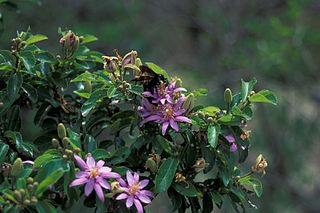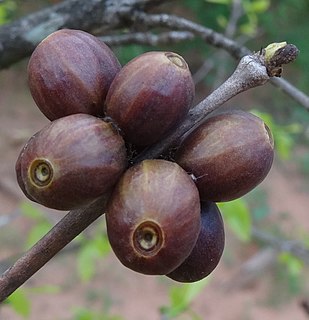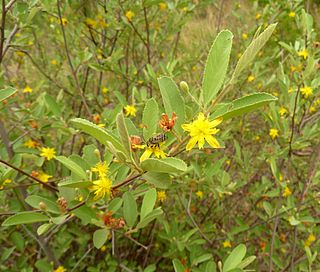
The Malvales are an order of flowering plants. As circumscribed by APG II-system, the order includes about 6000 species within 9 families. The order is placed in the eurosids II, which are part of the eudicots.

Tiliaceae is a family of flowering plants. It is not a part of the APG, APG II and APG III classifications, being sunk in Malvaceae mostly as the subfamilies Tilioideae, Brownlowioideae and Grewioideae, but has an extensive historical record of use.

The large flowering plant genus Grewia is today placed by most authors in the mallow family Malvaceae, in the expanded sense as proposed by the Angiosperm Phylogeny Group. Formerly, Grewia was placed in either the family Tiliaceae or the Sparrmanniaceae. However, these were both not monophyletic with respect to other Malvales - as already indicated by the uncertainties surrounding placement of Grewia and similar genera - and have thus been merged into the Malvaceae. Together with the bulk of the former Sparrmanniaceae, Grewia is in the subfamily Grewioideae and therein the tribe Grewieae, of which it is the type genus.
Glyphaea tomentosa is a species of flowering plant in the family Malvaceae sensu lato, or Tiliaceae or Sparrmanniaceae family. It is found only in Mozambique.
Grewia picta is a species of flowering plant in the family Malvaceae. It is found only in Seychelles. It is threatened by habitat loss.
Grewia bilocularis is a species of flowering plant in the family Malvaceae sensu lato or Tiliaceae or Sparrmanniaceae. It is found only in Yemen.
Grewia goetzeana is a species of flowering plant in the family Malvaceae sensu lato or Tiliaceae or Sparrmanniaceae. It is found only in Tanzania.
Grewia limae is a species of flowering plant in the family Malvaceae sensu lato or Tiliaceae or Sparrmanniaceae. It is found only in Mozambique.
Grewia milleri is a species of flowering plant in the Malvaceae sensu lato or Tiliaceae or Sparrmanniaceae family. It is found only in Yemen. Its natural habitat is rocky areas.

Grewia glandulosa is a species of flowering plant in the family Malvaceae sensu lato or Tiliaceae or Sparrmanniaceae. It is found only in Seychelles. It is threatened by habitat loss.
Grewia turbinata is a species of flowering plant in the family Malvaceae sensu lato or Tiliaceae or Sparrmanniaceae. It is found only in Yemen. Its natural habitat is subtropical or tropical dry forests.
Microcos erythrocarpa is a species of flowering plant in the family Malvaceae sensu lato or Tiliaceae or Sparrmanniaceae. It is a tree endemic to Peninsular Malaysia. It is threatened by habitat loss.
Thespesia mossambicensis is a species of flowering plant in the mallow family, Malvaceae, that is endemic to Mozambique.

Grewia retusifolia is a shrub species in the family Malvaceae. Common names include dysentery bush, emu-berry, dog's balls, turkey bush and diddle diddle. It is widespread in tropical and subtropical areas of Eastern Australia and Northern Western Australia. The species produces small, sweet, two-lobed fruit with a fibrous acidic pulp surrounding the seeds. Leichhardt described the fruits as having a very agreeable taste, which could be boiled to make a refreshing drink. Indigenous Australians use the bark and leaves in medications. The crushed leaves were used as a poultice to relieve toothaches.

Coffea racemosa, also known as racemosa coffee and Inhambane coffee, is a species of flowering plant in the family Rubiaceae. It has naturally low levels of caffeine, less than half of that found in Coffea arabica, and a quarter of that in Robusta coffee. It is endemic to the coastal forest belt between northern KwaZulu-Natal in South Africa and Zimbabwe, found in an area less than 150 km2 (58 sq mi) in size. It was widely cultivated by the Portuguese during the 1960-1970s in Mozambique, currently there are only two plantations at Ibo Island and in Hluhluwe, which remain.

Grewia flava, the brandy bush, wild currant, velvet raisin, or raisin tree, is a species of flowering plant in the family Malvaceae, native to southern Africa. A common shrub species, it is spreading into grasslands due to human rangeland management practices, and increasing rainfall. The berries are sweet and edible, but have little flesh and so are typically collected to ferment into alcoholic beverages. The desert truffle Kalaharituber pfeilii is often found in association with its roots.

Grewia flavescens, called rough-leaved raisin, sandpaper raisin, and donkey berry, is a species of flowering plant in the family Malvaceae, native to sub‑Saharan Africa, Yemen, Saudi Arabia, and India. It is considered to be an underutilized crop, both for its fruit and its use for livestock forage.

Grewia hexamita, the giant raisin, is a species of flowering plant in the family Malvaceae, native to Mozambique and adjoining countries. It is a large tree for a Grewia, reaching 5 m (16 ft). It is the most preferred woody plant of African savanna elephants, who browse on it in all seasons, unlike even other species of Grewia.
Grewia mollis is a widespread species of flowering plant in the family Malvaceae, native to tropical Africa, Yemen and Oman. It is the source of grewia gum, an edible polysaccharide mucilage, similar in its properties to tragacanth gum.










